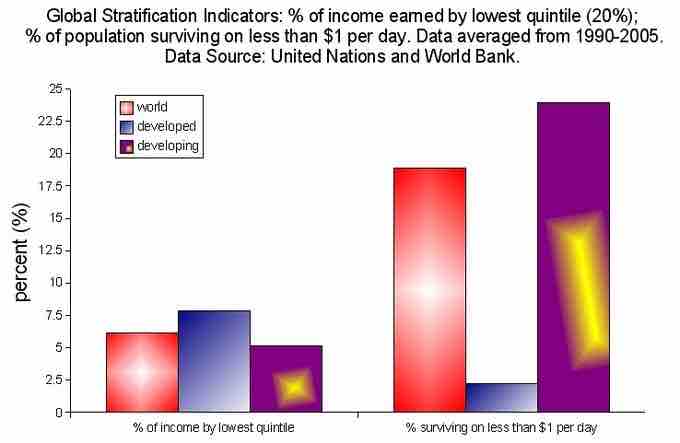Global stratification refers to the hierarchical arrangement of individuals and groups in societies around the world. Sociologists speak of stratification in terms of socioeconomic status (SES). Socioeconomic status is a measure of a person's position in a class structure. For example, a person may be designated as "lower class" or "upper class" based on their SES. A person's SES is usually determined by their income, occupational prestige, wealth, and educational attainment, though other variables are sometimes considered.
Inequality occurs when a person's position in the social hierarchy is tied to different access to resources. Inequality largely depends on differences in wealth. For example, a homeowner will have access to consistent shelter, while a person who cannot afford to own a home may have substandard shelter or be homeless. Because of their different levels of wealth, they have different access to shelter. Likewise, a wealthy person may receive higher quality medical care than a poor person, have greater access to nutritional foods, and be able to attend higher caliber schools. Material resources are not distributed equally to people of all economic statuses .

Global Stratification Indicators - Inequality and Income
Globally, the poorest 20% of the population, or lowest tier of the stratified economic order, makes a disproportionately small percentage of global income and lives off of a meager amount.
While stratification is most commonly associated with socioeconomic status, society is also stratified by statuses such as race and gender. Together with SES, race and gender shape the unequal distribution of resources, opportunities, and privileges among individuals. For example, within a given social class, women are less likely to receive job promotions than men. Similarly, within American cities with heavily racially segregated neighborhoods, racial minorities are less likely to have access to high quality schools than white people.
Perspectives on Stratification
Stratification is generally analyzed from three different perspectives: micro-level, meso-level, and macro-level.
Micro-level analysis focuses on how prestige and personal influence create inequality through face-to-face and small group interactions. For example, the more physically attractive a person is, the more likely they are to achieve status in small groups. This effect happens on a small-scale and is difficult to analyze as a uniform, widespread occurrence. Thus, stratification based on levels of physical attractiveness is analyzed as a micro-level process.
Meso-level analysis of stratification focuses on how connections to organizations and institutions produce inequality. For example, parents, teachers, and friends convey expectations about one's class position that teach different skills and values based on status. These educational disparities occur in the small setting of a classroom, but are consistent across a wide range of schools. Thus, they are analyzed as meso-level phenomena that reinforce systems of inequality.
Macro-level analysis of stratification considers the role of international economic systems in shaping individuals' resources and opportunities. For example, the small African nation of Cape Verde is significantly indebted to European nations and the U.S., and the majority of the nation's industry is controlled by foreign investors. As the nation's economy has ceded control of once public services, such as electricity, its citizen have lost jobs and the price of electricity has increased. Thus, the nation's position in the world economy has resulted in poverty for many of its citizens. A global structure, or a macro-level phenomenon, produces unequal distribution of resources for people living in various nations.
Theories of Macro-Level Inequality
There are three dominant theories that sociologists use to consider why inequality exists on a global scale. First, some sociologists use a theory of development and modernization to argue that poor nations remain poor because they hold onto traditional attitudes and beliefs, technologies and institutions. According to this theory, in the modern world, the rise of capitalism brought modern attitudes, modern technologies, and modern institutions which helped countries progress and have a higher standard of living. Modernists believe economic growth is the key to reducing poverty in poor countries.
Second, dependency theory blames colonialism and neocolonialism (continuing economic dependence on former colonial countries) for global stratification. Countries have developed at an uneven rate because wealthy countries have exploited poor countries in the past and today through foreign debt and transnational corporations (TNCs). According to dependency theory, the key to reversing inequality is to relieve former colonies of their debts so that they can benefit from their own industry and resources.
Lastly, world systems theory suggests that all countries are divided into a three-tier hierarchy based on their relationship to the global economy, and that a country's position in this hierarchy determines its own economic development. In this model nations are divided into core, semiperipheral, and peripheral countries. Core nations (e.g. the United States, France, Germany, and Japan) are dominant capitalist countries characterized by high levels of industrialization and urbanization. Semiperipheral countries (e.g. South Korea, Taiwan, Mexico, Brazil, India, Nigeria, and South Africa) are less developed than core nations but are more developed than peripheral nations. Peripheral countries (e.g. Cape Verde, Haiti, and Honduras) are dependent on core countries for capital, and have very little industrialization and urbanization.